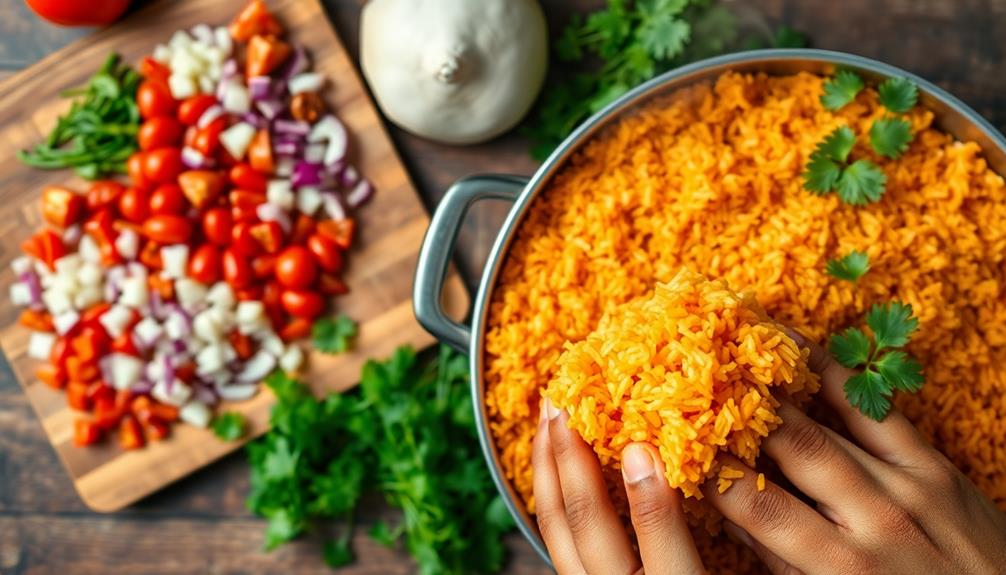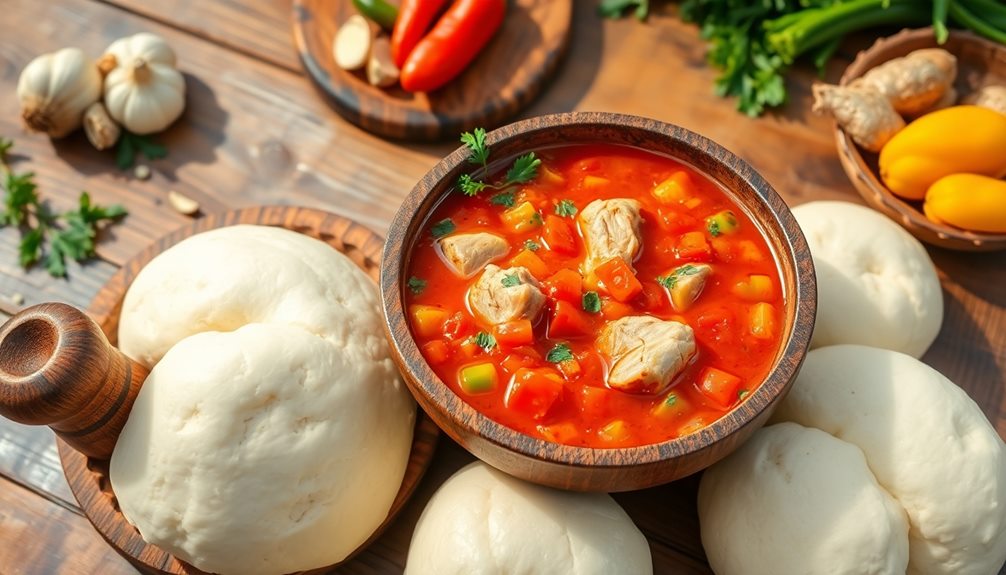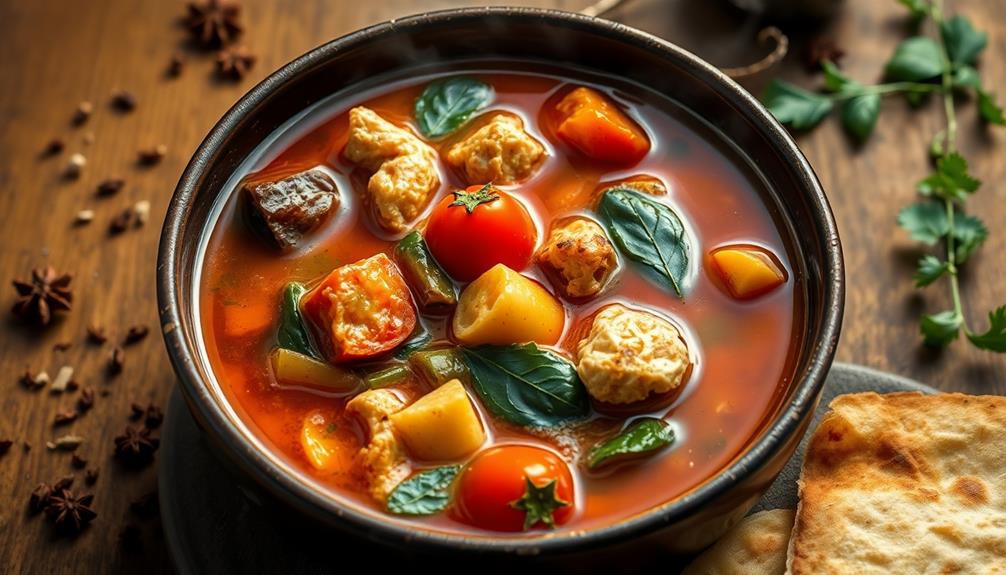Jollof rice, the vibrant and flavorful staple of West Africa, has captivated the culinary world! This colorful one-pot dish traces its roots back to the 14th century, with each country adding its own unique twist. Whether you're sautéing tomatoes and onions or layering in aromatic spices, mastering the recipe is a rewarding culinary adventure. Jollof rice is more than just a meal – it's a celebration of cultural pride and a medium for storytelling. The Jollof Rice Showdown has sparked global interest, encouraging you to explore the rich tapestry of West African cuisine. There's so much more to discover!
Key Takeaways
- Jollof rice is a beloved West African dish with a rich cultural history, representing unity and family gatherings.
- The dish features a vibrant blend of long-grain rice, tomatoes, spices, and stock, showcasing the diverse flavors of the region.
- Mastering the art of Jollof rice cooking requires skillful techniques, such as soaking the rice and layering flavors through sautéing and simmering.
- Jollof rice competitions and events have gained popularity, promoting awareness of West African cuisine and fostering community engagement through culinary exploration.
- The enduring popularity of Jollof rice inspires continued appreciation for the rich tapestry of West African culinary traditions and the fusion of flavors.
History
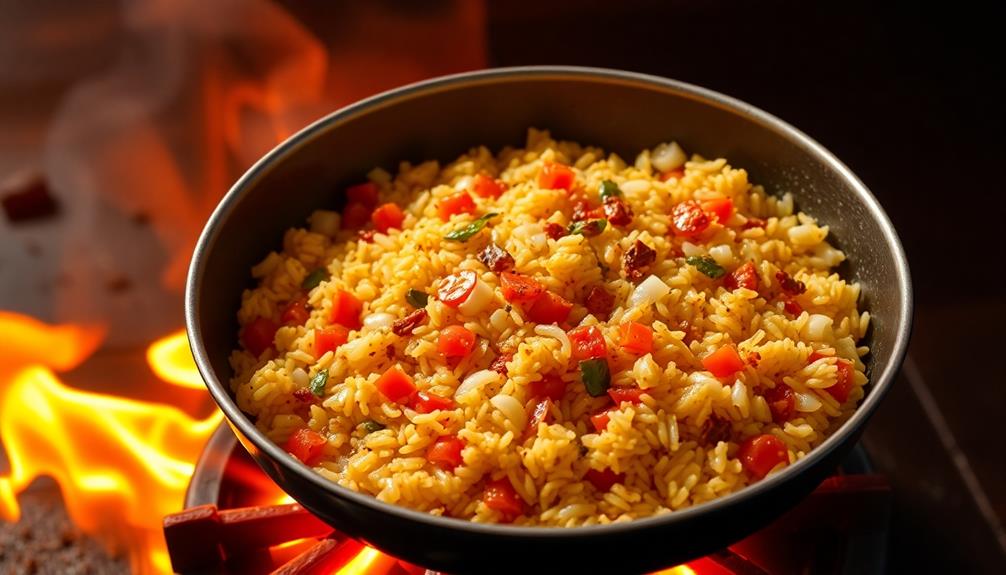
Jollof rice has long been a staple dish across West Africa, with its origins tracing back to the 14th century. This vibrant, one-pot meal has captivated the hearts and taste buds of people throughout the region.
From the bustling streets of Lagos to the serene villages of Senegal, the aroma of simmering tomatoes, onions, and spices wafts through the air, drawing everyone to the table.
The dish's name is believed to have originated from the Wolof people of Senegal, who referred to it as "benachin." Over the centuries, Jollof rice has evolved, with each country and community putting their own unique spin on the recipe.
Some add chicken or shrimp, while others prefer a vegetarian version. Regardless of the variations, one thing remains constant: the irresistible blend of flavors that make Jollof rice a true culinary delight.
Recipe
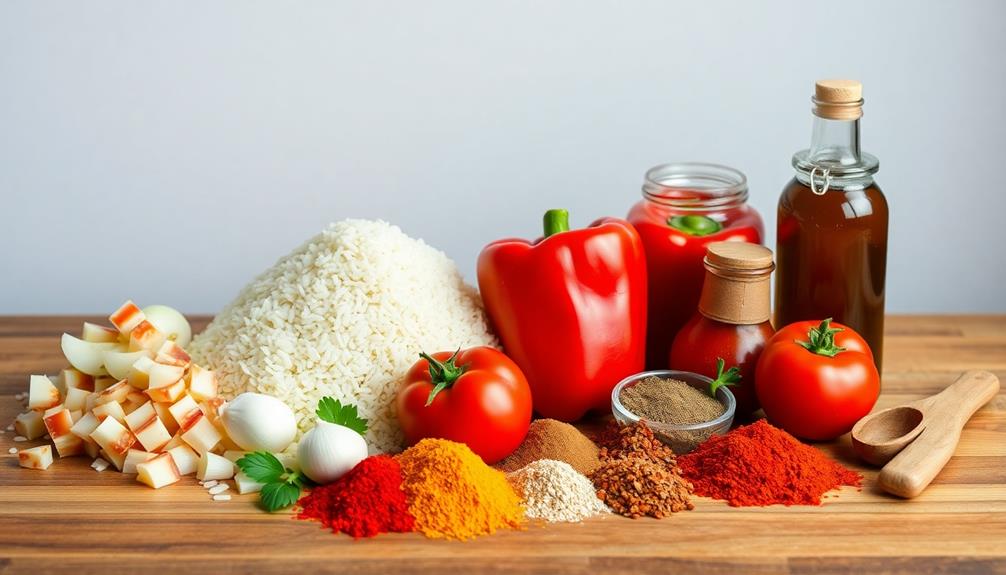
Jollof rice is a beloved West African dish that has become a source of cultural pride and friendly rivalry. This vibrant and flavorful dish is a staple in the cuisines of countries like Nigeria, Ghana, and Senegal, each with its own unique spin on the classic recipe.
At its core, jollof rice is a one-pot wonder, combining fragrant spices, succulent tomatoes, and tender grains of rice into a harmonious medley. Whether you're a seasoned chef or a novice in the kitchen, mastering the art of jollof rice can be a rewarding culinary adventure.
Ingredients:
- 2 cups long-grain rice
- 2 tablespoons vegetable oil
- 1 onion, diced
- 3 cloves garlic, minced
- 1 red bell pepper, diced
- 2 tomatoes, diced
- 2 cups tomato passata or crushed tomatoes
- 2 cups chicken or vegetable stock
- 1 teaspoon curry powder
- 1 teaspoon paprika
- 1/2 teaspoon cayenne pepper (or to taste)
- Salt and black pepper to taste
Cooking Instructions:
In a large pot or Dutch oven, heat the vegetable oil over medium heat. Add the diced onion and sauté until translucent, about 5 minutes. Stir in the minced garlic and cook for an additional minute until fragrant.
Add the diced bell pepper, tomatoes, tomato passata, stock, curry powder, paprika, and cayenne pepper. Bring the mixture to a boil, then reduce the heat to low, cover, and simmer for 15 minutes. Uncover, stir in the rice, and continue to simmer for an additional 20-25 minutes, or until the rice is tender and the liquid is absorbed.
Tips:
For an authentic taste, consider using Nigerian or Ghanaian jollof seasoning blends, which can include ingredients like ginger, thyme, and ground crayfish.
Adjusting the spice level to your preference is also recommended, as some enjoy a fiery kick while others prefer a milder version. Serve the jollof rice hot, garnished with fresh herbs or a dollop of yogurt, and prepare to be transported to the vibrant flavors of West Africa.
Cooking Steps
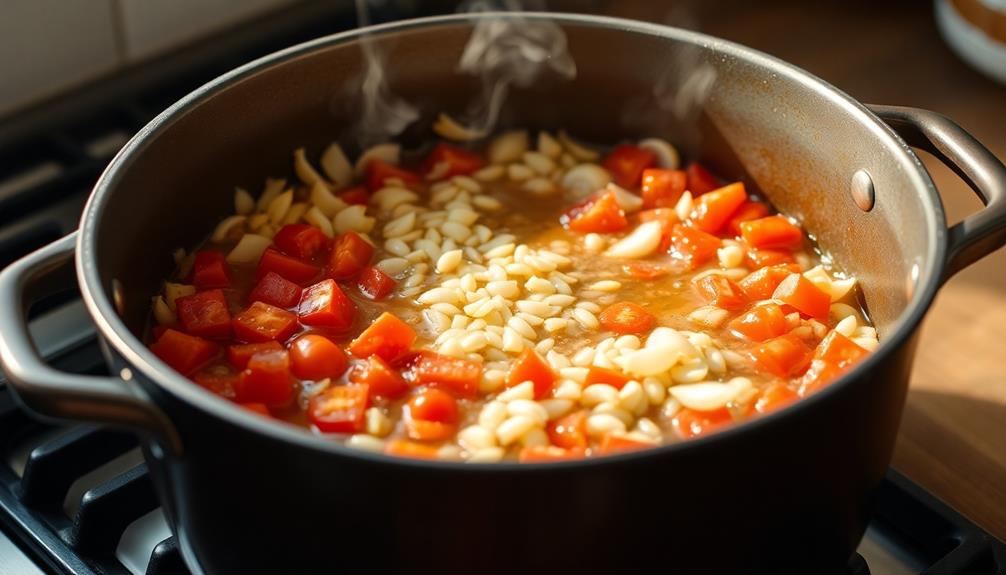
Soak the rice overnight to get that perfect texture.
Drain the rice thoroughly before cooking.
Next, sauté the onions and tomatoes to build the base flavors.
Now, add your blend of spices and seasonings to make it really sing.
Step 1. Soak Rice in Water Overnight
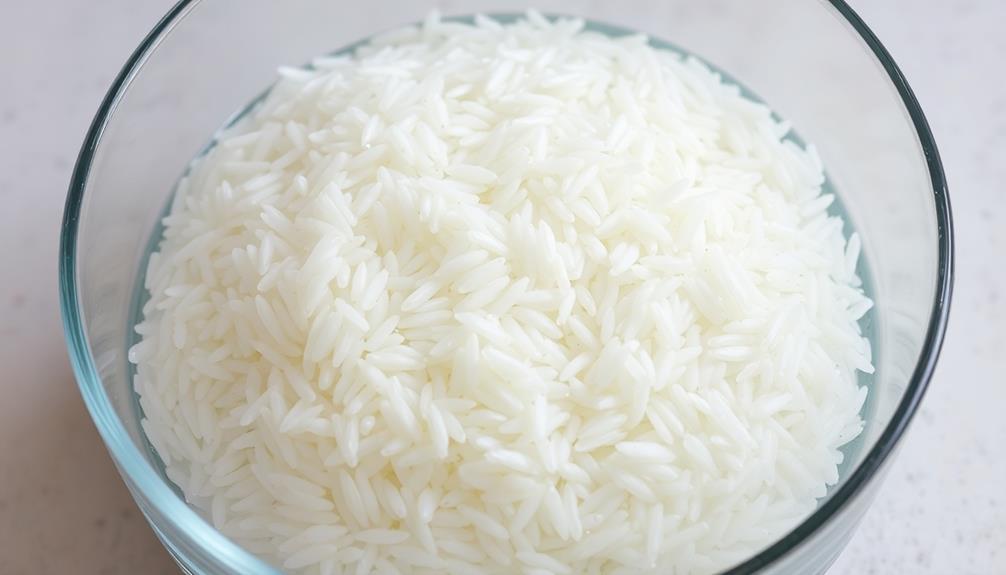
Before you start cooking, it's important to properly soak the rice. Soaking the rice in water overnight helps to soften the grains and reduce the cooking time. Simply place the rice in a large bowl, cover it with water, and let it sit overnight. This easy step makes a big difference in the texture and flavor of your Jollof rice.
In the morning, you'll notice the rice has expanded and become more pliable. Drain the water and give the rice a quick rinse. This helps to remove any excess starch, ensuring your Jollof rice doesn't turn out sticky or mushy.
With the rice prepped and ready to go, you can move on to the next steps of the cooking process with confidence. Soaking the rice is a simple yet crucial part of making the perfect Jollof rice, so don't skip this important first step!
Step 2. Drain Soaked Rice Thoroughly
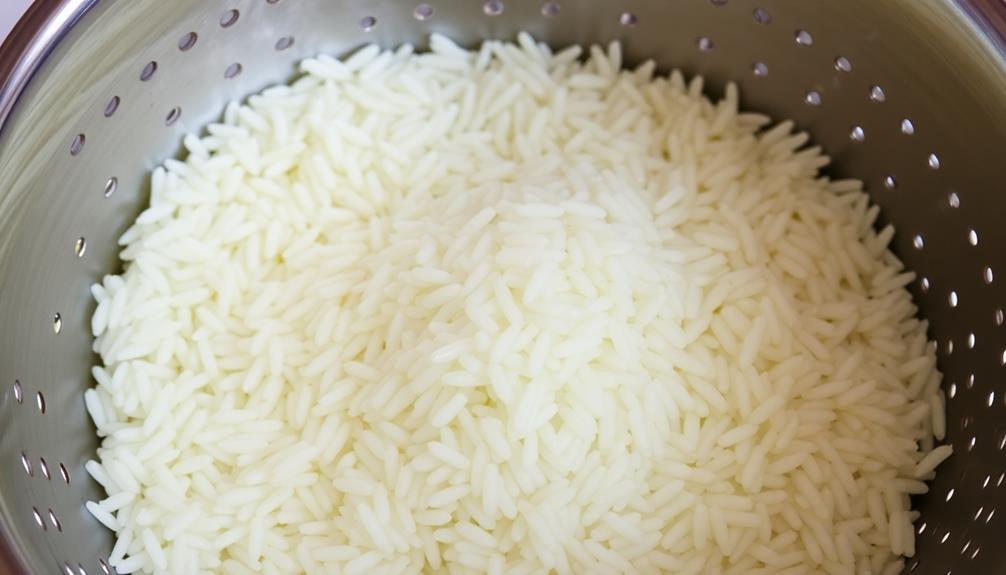
After letting the rice soak overnight, you'll want to thoroughly drain it. Grab a mesh strainer or colander and carefully pour the soaked rice into it. Give it a few gentle shakes to allow any excess water to drip off. You don't want any standing water left behind, as that can lead to soggy, mushy rice later on.
Once drained, transfer the rice to a clean, dry bowl. Use your hands to fluff and separate the grains, ensuring they're not clumped together. This step is crucial for achieving the perfect, fluffy texture in your final jollof rice dish.
Next, you can move on to the exciting step of sautéing the aromatics. Get ready to fill your kitchen with the mouthwatering scents of onions, garlic, and spices!
With the rice properly drained, you're one step closer to creating an authentic, flavor-packed jollof rice masterpiece.
Step 3. Sauté Onions and Tomatoes
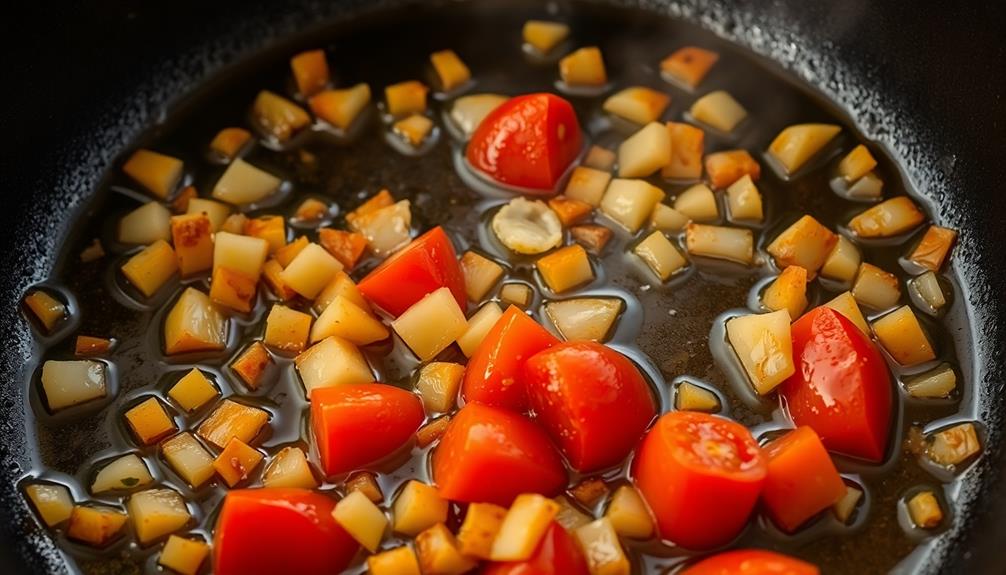
With the rice properly drained and ready to go, it's time to turn your attention to the aromatic foundation of your jollof rice dish.
Grab your trusty sauté pan and heat it over medium-high heat. Once the pan is hot, add a generous drizzle of olive oil.
Now, it's time to add the star players – diced onions and juicy tomatoes. Sauté these fragrant ingredients, stirring frequently, until the onions are translucent and the tomatoes have softened.
This step is crucial, as the caramelized onions and cooked tomatoes will impart a deep, rich flavor to your jollof rice.
Be sure to season with a pinch of salt and a sprinkle of black pepper to enhance the natural sweetness of the vegetables.
As the aromas fill your kitchen, you'll know you're on the right track to creating a truly authentic and mouthwatering jollof rice dish.
Keep an eye on the pan, adjusting the heat as needed, until the onions and tomatoes reach the perfect level of doneness.
Step 4. Add Spices and Seasonings

Once the onions and tomatoes have reached the desired level of caramelization, it's time to introduce the aromatic spices that will elevate your jollof rice to new heights.
First, add a generous amount of curry powder, which will infuse the dish with a warm, earthy flavor. Don't forget to also sprinkle in some thyme, whose herbaceous notes will balance the richness of the stew.
Next, it's time for the star of the show – the blend of spices that truly make jollof rice unique. Stir in a pinch of cumin, whose smoky undertones will add depth, and a dash of garlic powder to create a mouthwatering aroma.
Step 5. Add Chicken or Fish

Now that you've infused your jollof rice base with a symphony of aromatic spices, it's time to elevate the dish even further by adding your protein of choice.
Whether you prefer the juicy, tender chunks of chicken or the flaky, delicate fillets of fish, both options will take your jollof rice to new heights of flavor.
For the chicken-lovers, simply sear the pieces in a pan until they're golden brown, then nestle them into the fragrant rice. As the chicken simmers, it'll soak up all the incredible seasonings, creating a mouthwatering harmony of textures and tastes.
Fish, on the other hand, lends a delicate touch, perfectly complementing the bold jollof flavors. Gently poach the fillets in the rice or bake them on top, allowing the flaky fish to mingle with the vibrant tomato-based sauce.
No matter which protein you choose, the result will be a true feast for the senses, packed with layers of flavor that'll have your family and friends clamoring for seconds.
Final Thoughts
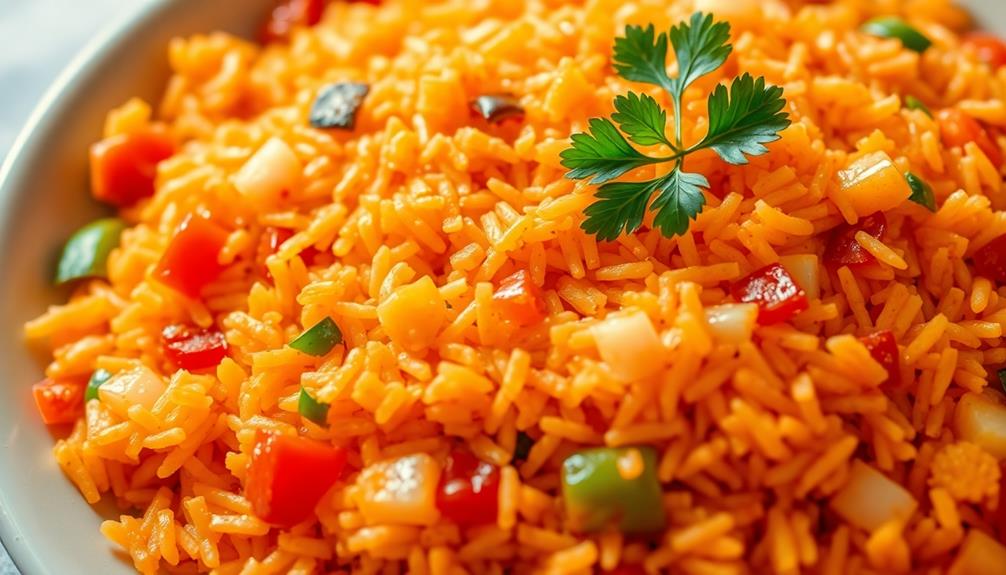
Ultimately, the Jollof Rice showdown has been a captivating culinary journey, each recipe showcasing the rich diversity and passion of its creators.
Whether you've indulged in the bold, smoky flavors of the classic dish or the creative fusions of chicken or fish, you've been taken on a delightful adventure through the vibrant West African cuisine.
The showdown has highlighted the cultural significance of Jollof Rice, a dish that brings families and communities together, celebrating tradition and innovation.
As you savor the final bites, you can't help but feel a sense of appreciation for the dedication and artistry that goes into each mouthwatering preparation.
Moving forward, the Jollof Rice showdown has inspired you to explore more of the incredible flavors and stories that West African cuisine has to offer.
It's a culinary experience that has left an indelible mark, and you're already looking forward to the next delicious chapter.
Frequently Asked Questions
What Are the Regional Variations of Jollof Rice?
Regional variations of jollof rice can be found across West Africa. You'll find zesty Ghanaian jollof, smoky Nigerian jollof, and mild Senegalese jollof, each showcasing unique spices and cooking methods that reflect the diverse cultures of the region.
How Can I Make Jollof Rice Vegetarian or Vegan?
To make jollof rice vegetarian or vegan, you can swap out the meat for plant-based proteins like chickpeas, lentils, or tofu. You can also use vegetable broth instead of chicken broth and omit any dairy products.
What Is the Best Way to Reheat Leftover Jollof Rice?
To reheat leftover jollof rice, you can use the stovetop or microwave. On the stovetop, add a splash of water or broth, cover and heat over medium-low, stirring occasionally. In the microwave, heat in short bursts, stirring between intervals, until heated through.
Can Jollof Rice Be Served as a Side Dish?
Absolutely, jollof rice can be served as a side dish. Its bold, savory flavors pair wonderfully with many main dishes, making it a versatile accompaniment. You can enjoy jollof rice alongside grilled meats, stews, or even as a vegetarian option.
How Can I Adjust the Spice Level in Jollof Rice?
To adjust the spice level in jollof rice, you can start by reducing the amount of hot chili peppers or spices you use. You can also add more tomatoes, onions, or stock to balance out the heat.
